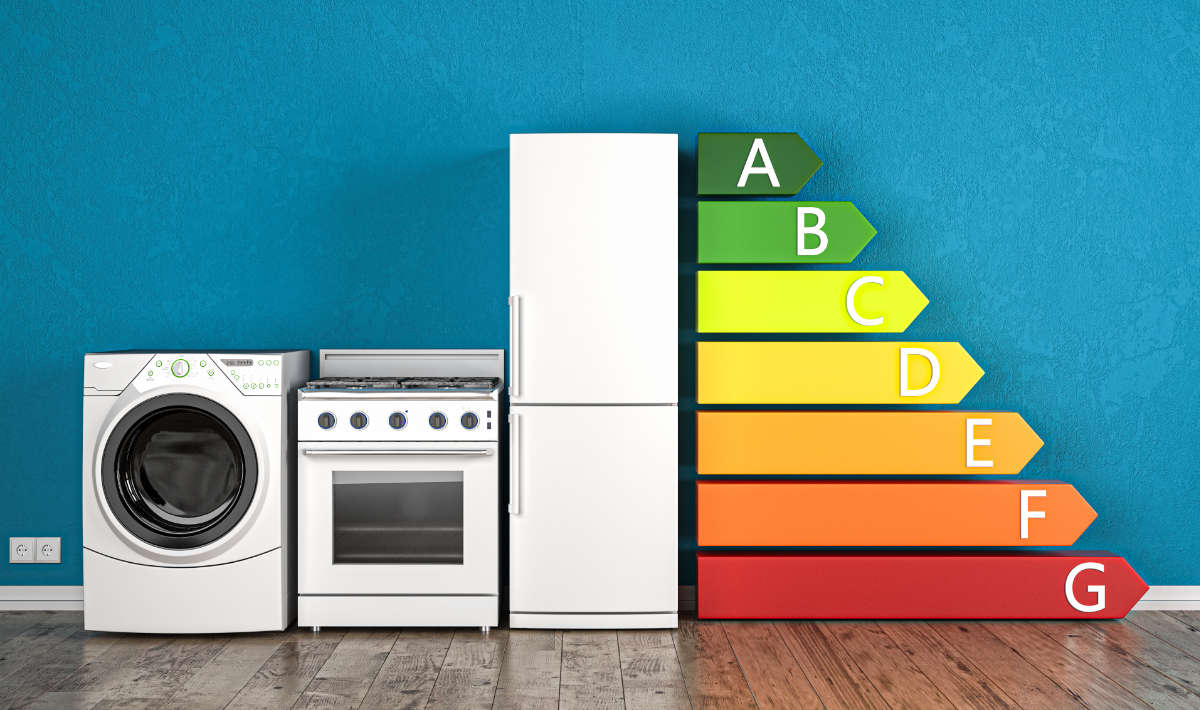Is your dishwasher broken? Or is your washing machine beyond repair? When it’s time to replace a kitchen appliance, it’s an ideal time to choose one that’s energy efficient.
Buying an energy-efficient appliance is an easy way to reduce your carbon footprint, and it could save you money in running costs too. For example, the Energy Saving Trust claims that if you buy an energy-efficient fridge, you could save about £190 in energy bills over its 17-year lifetime. If you opt for an energy-efficient dishwasher, the savings, according to Which? is around £300 over its lifetime.
Energy efficient appliances: the new energy label
Why do we need energy-efficient appliances in our homes? Daily usage of the likes of fridge-freezers, dishwashers and washing machines means we’re using more and more energy, and as a result, carbon emissions are accelerating climate change. To help protect the planet for future generations, everyone has a role to play, and buying energy-efficient appliances is one way to look after the world’s environment.
However, despite wanting to live more sustainably, sometimes it’s difficult to know what’s really energy efficient and what’s not. That’s why a new energy label now appears on many household appliances to help us better understand energy consumption. Introduced in March this year, shoppers can now refer to a simple A to G scale, instead of one that includes A+, A++ and A+++ ratings, and see instantly how an appliance fares — A is the most energy efficient, G the least.
Don’t panic, however, if you’re keen to be green and can only find B and C ratings on kitchen appliances. That’s because the reset scale is leaving room for manufacturers to further develop their products. A-rated appliances are something to look out for in the future. Remember too, that energy-efficient appliances may still be expensive to use, especially if it’s a large American-style fridge-freezer, or you wash a full load daily. For these examples, the new energy labels provide figures so you can be better informed about running costs.
Icons on the new labels display energy consumption in kilowatts (kW), helping you to compare models — the lower the number, the more money you should save on household bills. Water consumption in relevant appliances is highlighted too, so again potential savings can be seen at a glance.
Another new feature is a QR code. Scan this with your smartphone and you’ll access yet more useful product information.
Appliances guide
The new energy efficiency scale applies to dishwashers, household refrigerators and freezers, washing machines and washer-dryers — you’ll see them on TVs and computer monitors too. More appliances, including tumble dryers, will be on sale with new labels in 2022.
If choosing an energy-efficient appliance for your kitchen, here’s what to look out for.
Dishwashers
As well as a rating in the new A-G scale, dishwasher labels now include the energy consumption for an Eco setting, based on 100 cleaning cycles. The water used for this Eco setting is also highlighted in litres and the duration of an Eco setting is shown — which is often a good bit longer than a standard wash, so useful to know when comparing models.
An additional feature, beneficial to those of us who enjoy open-plan living, is information about noise emissions. Note that anything below 45 decibels (dB) is usually considered quiet.
Top tip: Only run your dishwasher when it’s full, opt for the energy-saving setting — this uses, on average, 30% less energy and water — and if you have an electricity tariff that charges less per unit during the night, set the delay start so that your dirty dishes are washed while you’re asleep.
Best-selling dishwasher
Stuck for inspiration? Check out our list of best-selling Amazon products!
No products found.
Fridges, freezers and fridge-freezers
When it comes to fridges, freezers and fridge-freezers, it’s easy to see why we need energy-efficient appliances. Unlike other white goods in your kitchen, these are always switched on, so they guzzle energy. The new energy efficiency rating takes into account the room temperature and the number and size of storage compartments.
Other label information includes the total volume of the chilled and frozen compartments, and there’s a new icon representing noise levels, with more details included about noise emissions.
Top tip: Stand your fridge 10cm away from the wall so that air can circulate around it allowing the appliance to work more efficiently. Never leave the door open for longer than is necessary — the fridge will just fill with warm air and use more energy cooling down again. The optimum temperature for a fridge is O-5°C.
Washing machines
The new label on washing machines shows the energy used for 100 washes. You’ll find additional data on the capacity and duration of ‘Eco 40-60’ programmes, water consumption per litre and noise emission information, so you’ll now know just how loud that final spin will be — handy if you have an open-plan kitchen and living area.
Top tip: Wash at a lower temperature. Which? research has found that choosing the 30°C programme rather than the 40°C wash can cut energy costs by 38%. If you opt for the 20°C cycle, this reduces further to 62%. If you’re keen to wash at lower temperatures, a liquid detergent rather than washing powder will wash your clothes better.
Best-selling washing machines
Stuck for inspiration? Check out our list of best-selling Amazon products!
No products found.
Washer-dryers
You’ll notice two energy efficiency ratings on washer-dryer labels — the left side is for washing and drying, and the right is for washing alone. Like washing machines, the new energy label gives details about the energy consumption per 100 ‘Eco’ washes and the noise level of the final spin. There’s also information about water consumption, the duration of the energy-efficient programme and the drum capacity — useful if you live in a large household.
Top tip: Research suggests we generally only make use of 80% of the washing capacity of washer-dryers, so always try to have a full load. Also, make sure that when you’re drying your clothes you separate different fabrics which will speed up the drying time. Loosening your laundry will aid this too.
Tumble dryers
It’s estimated that we tumble dry more than 1,200kg of clothes every year, yet the new energy efficiency label is not expected to appear on tumble dryers in 2022. When looking for an eco-friendly model, note that heat pump dryers are usually the most efficient.
Top tip: If you have time, and the weather allows, try to dry your clothes outside on a washing line. Otherwise, hang them indoors in a well-ventilated room.
You may be interested in…
This article may include affiliate links to products and services where we may receive a small fee to support the running of this site if you make a purchase or is a sponsored article from one of our select editorial partners providing valuable advice and information to our readers.































































